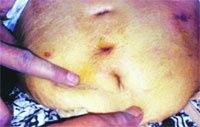Mycobacterium massiliense is a species of slow-growing, non-tuberculous mycobacteria, which is closely related to M. abscessus and M. bolletii. It is an opportunistic pathogen that is associated with a wide range of infections in humans, including skin and soft tissue infections, pulmonary infections, and infections of the central nervous system. In recent years, an epidemic caused by a unique clone of M. massiliense has emerged in several countries, including Brazil, South Korea, and the United States. This essay will explore the characteristics of this epidemic and the measures that have been taken to control its spread.
Characteristics of the Epidemic:
The epidemic caused by the unique clone of M. massiliense is characterized by a high degree of genetic homogeneity among the clinical isolates. This suggests that the epidemic is caused by a single clone of the bacterium that has acquired a set of virulence factors that enable it to cause disease in humans. The epidemic first came to the attention of public health officials in Brazil in 2014 when a large number of cases of skin and soft tissue infections were reported in patients who had undergone cosmetic procedures at a particular clinic. The outbreak was eventually traced to contaminated tap water that was used to prepare the solutions that were injected into the patients. The water was found to be contaminated with a strain of M. massiliense that was genetically identical to the strain that had been isolated from the infected patients.
The outbreak in Brazil was followed by similar outbreaks in South Korea and the United States. In South Korea, the outbreak was associated with a hospital that specialized in cosmetic surgery. The outbreak began in 2015 and continued until 2017, infecting over 200 patients. In the United States, the outbreak was associated with a single cosmetic surgery center in California. The outbreak began in 2016 and continued until 2018, infecting over 80 patients.
The clinical presentations of the infections caused by the unique clone of M. massiliense vary depending on the site of infection. In most cases, the infections are localized to the skin and soft tissues and present as abscesses or cellulitis. However, the bacterium can also cause pulmonary infections, central nervous system infections, and infections of other organs.
Measures to Control the Spread of the Epidemic:
The emergence of the epidemic caused by the unique clone of M. massiliense has led to the implementation of several measures to control its spread. These measures include:
-
Improving Infection Control Practices: Infection control practices have been improved in healthcare facilities that are at high risk of transmitting the bacterium, such as hospitals and clinics that perform cosmetic procedures. This includes increasing the frequency of hand hygiene, implementing contact precautions, and using appropriate disinfectants to clean equipment and surfaces.
-
Surveillance: Public health officials have implemented surveillance systems to monitor the incidence of infections caused by M. massiliense and to track the spread of the unique clone. This includes monitoring the genetic profiles of the bacterium and identifying any new outbreaks that may occur.
-
Education: Healthcare providers and patients have been educated about the risks associated with infections caused by M. massiliense and the measures that can be taken to prevent infection. This includes providing information about hand hygiene, the importance of using sterile equipment, and the risks associated with cosmetic procedures.
-
Regulation: Regulatory bodies have implemented new regulations to ensure that healthcare facilities that perform cosmetic procedures follow appropriate infection control practices. This includes requiring facilities to use sterile solutions for injections and to properly disinfect equipment and surfaces.
Conclusion:
The epidemic caused by the unique clone of M. massiliense is a significant public health threat that has affected several countries around the world. The high degree of genetic homogeneity among the clinical isolates suggests that the epidemic is caused by a single clone of the bacterium that has acquired virulence factors that enable it to cause disease in humans. The outbreak first came to the attention of public health officials in Brazil in 2014, and since then, similar outbreaks have been reported in South Korea and the United States.
In response to the epidemic, measures have been implemented to control its spread, including improving infection control practices, surveillance, education, and regulation. These measures have been effective in reducing the incidence of infections caused by the unique clone of M. massiliense in some countries. However, the ongoing nature of the epidemic highlights the need for continued vigilance and coordinated efforts across countries to prevent the spread of the bacterium.
Furthermore, more research is needed to fully understand the characteristics of the unique clone of M. massiliense and the factors that have contributed to its emergence and spread. This includes identifying the specific virulence factors that enable the bacterium to cause disease in humans and understanding the environmental factors that have led to its contamination of water sources.
In conclusion, the epidemic caused by the unique clone of M. massiliense is a significant public health threat that requires ongoing attention and coordinated efforts to control its spread. Improved infection control practices, surveillance, education, and regulation are important measures that can help prevent the spread of the bacterium. However, continued research is needed to fully understand the characteristics of the bacterium and develop effective strategies to prevent and treat infections caused by this emerging pathogen.
